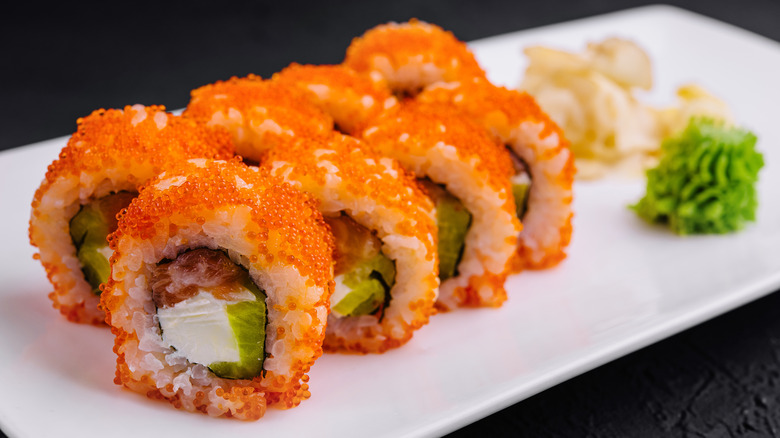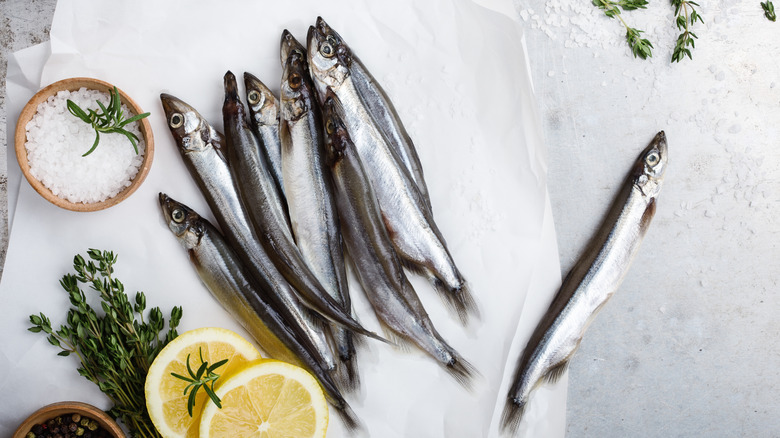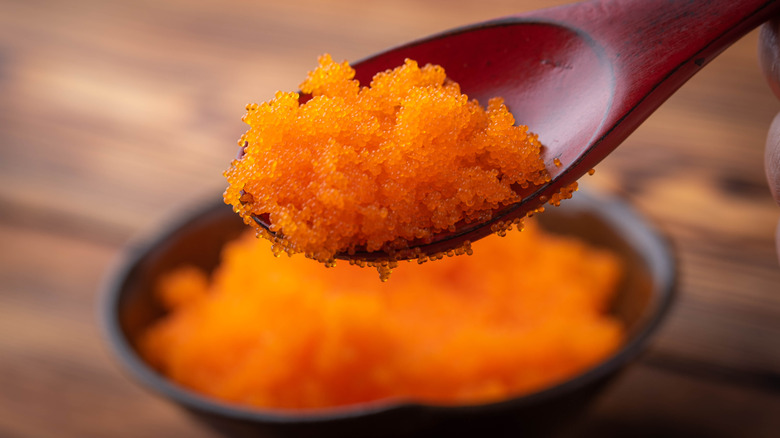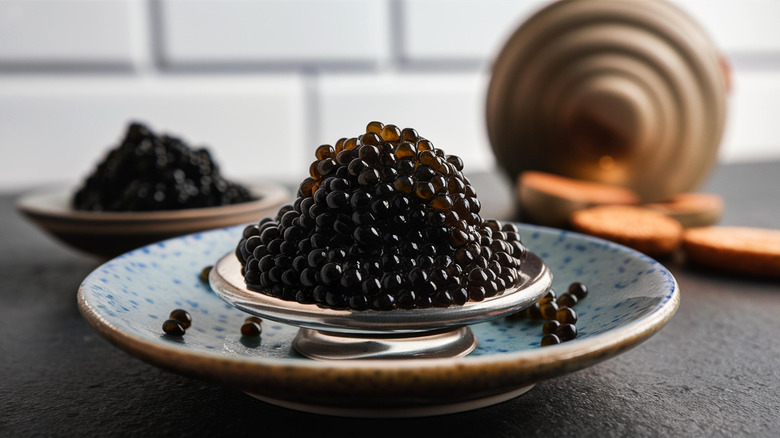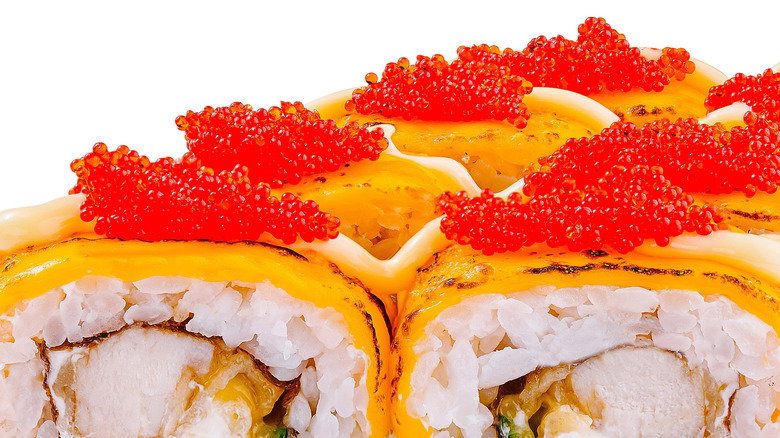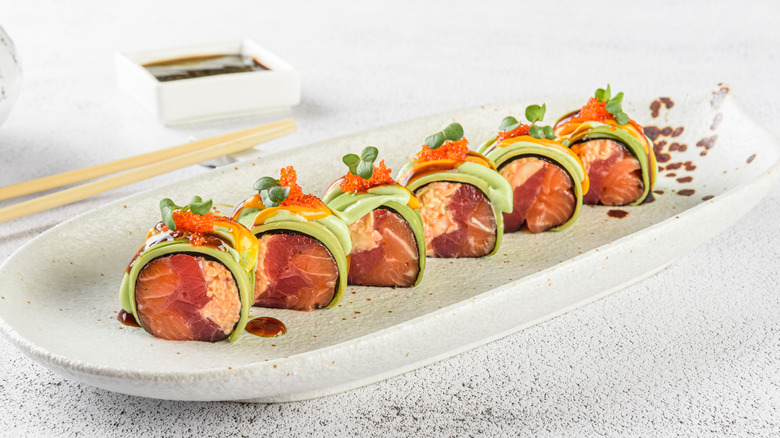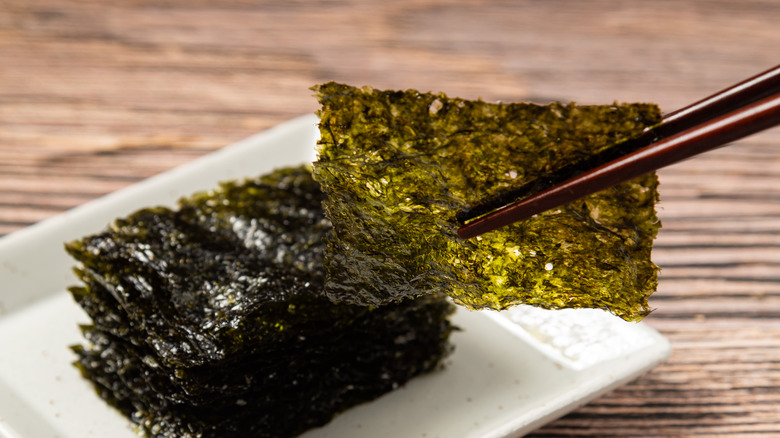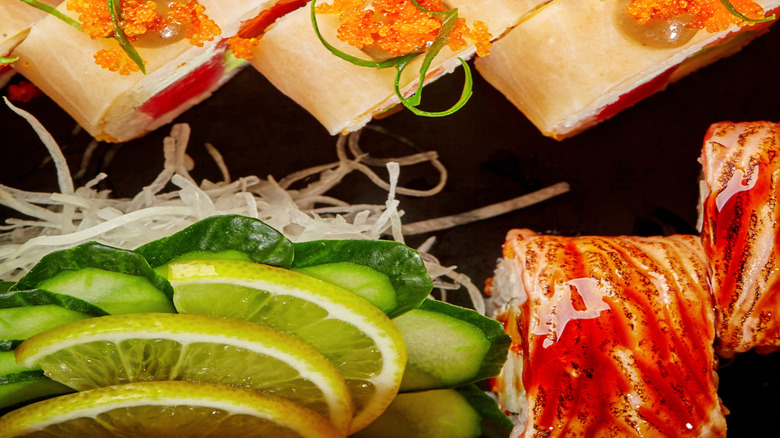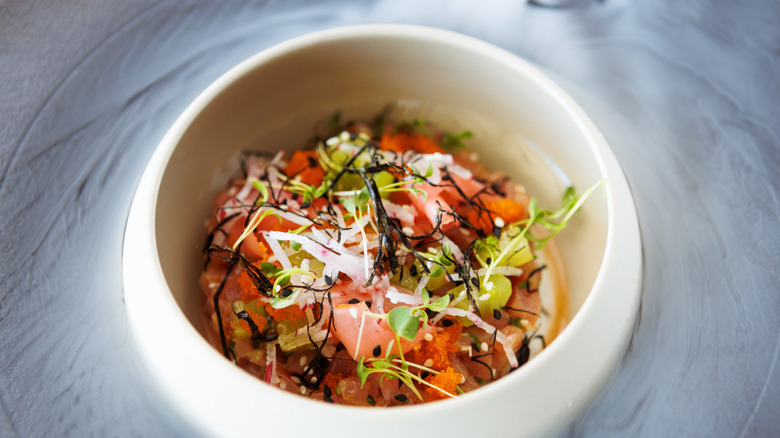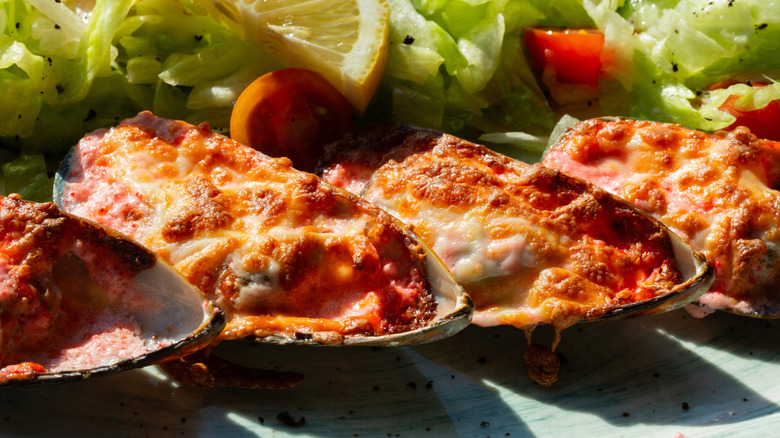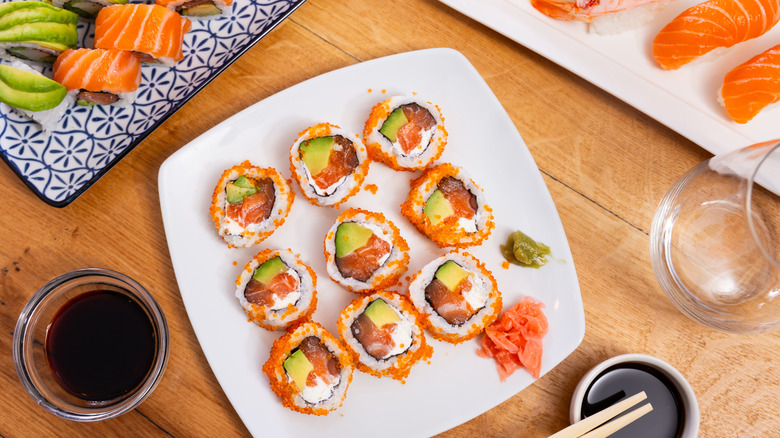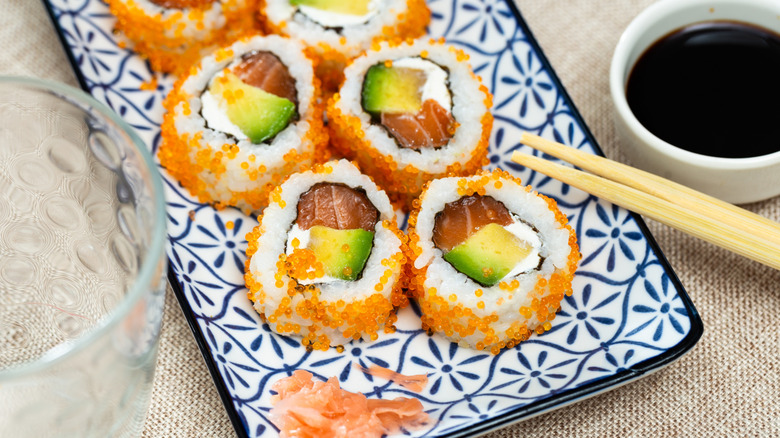What Is Masago And How Do You Eat It?
We may receive a commission on purchases made from links.
If you've ever ordered up a specialty roll at a sushi restaurant or sat down at a track and pulled off a plate, and then noticed those teeny orange balls that crown the top of a sushi dish, you've doubtless encountered masago. If you thought about it at all, you likely realized that those were fish eggs, but masago is actually more specific than that.
Masago shares many qualities with other types of fish roe, but with some specific taste and texture virtues that make it uniquely suited to sushi dishes. Whether you're an adventurous home cook or simply want to know what you're eating when you go out, it's useful to understand this ingredient in more detail. Chowhound sat down with some experts to do just that. The good news? Because masago is easy to learn to use, and because it's widely available in the United States, it no longer falls into the category of specialty ingredients. Its magical garnishing powers and culinary deliciousness can be yours for the taking!
What is masago?
All right, so you're looking to level up your sushi-eating powers. This classic Japanese tradition is all about grace and delicacy, which is why masago is such a good fit with many different rolls. It's not just any roe, either.
"Masago comes from capelin (Mallotus villosus), which is a type of smelt fish," explains Jacobo Lopez Ramirez, head sushi chef at Uchiko Austin. "They are often fried or grilled whole. In Japan smelt with roe inside are preferred; they are called komochi shishamo." For the most part, that's how one had to enjoy masago, as keeping the eggs fresh was too difficult. However, he explains, the recent introduction of medical-grade freezers to the culinary scene has given chefs access to masago on its own, since now it can "be processed and stored during peak spawning season. "
Capelin fish are "found in the cold waters of the North Atlantic Ocean, such as those around Norway and Iceland," says Rik Keijzer of School of Sushi. "A similar fish is also caught in the Pacific. These fish are sustainably harvested, and their eggs are carefully collected." So for the most part, you can feel comfortable buying and eating masago.
A brief history of masago
Traditional sushi is all about the delicious, sweet, vinegared rice, which is supposed to be the star of the show — explaining both why sushi rice is sticky and why cold grocery store sushi is so disappointing. While the Americanized version focuses more on the flavors of fish and veggies and sauce, the sushi you'll find in more traditional locales is all about well-made rice with delicate accompaniments. Masago, of course, fits right in.
"This roe has been a delicacy in Japan and other Asian countries for centuries," Rik Keijzer says. "The word 'masago' means 'sand' in Japanese, as the eggs resemble tiny grains of sand." Today, its luxurious taste has made it hugely popular in sushi restaurants across the world.
"While it doesn't have the same posh backstory as caviar," says James Callery, head chef at Cross Keys Newbury, "it's been embraced in Japanese cuisine as a fun way to add flavor and texture to sushi. Let's say it's been 'popping' up in sushi bars around the world for good reason."
What's in a name: Masago vs caviar
So if caviar is not the same thing as masago, what is it? Backing this train up an extra step, many people wonder if fish eggs and roe are even different — the answer is no, not really, though roe does refer specifically to fully ripe and unfertilized fish eggs. As for caviar, it comes from sturgeon (Acipenseridae family) rather than capelin.
"Although both are types of fish roe, they are two entirely different products and are used differently," Rik Keijzer explains. "Caviar is considered a luxury product due to its limited availability and the complex harvesting methods involved, making it quite expensive. Masago, on the other hand, is much more affordable." Price isn't their only difference, he continues, as they also differ in flavor, size, and texture. While masago is soft and salty, caviar is creamy and buttery, a bit brinier, and larger than masago. "It's like comparing a cozy B&B to a five-star hotel," James Callery adds. "Masago is more budget-friendly and has a milder, less briny taste."
Japanese cuisine uses other types of roe as well. "Ikura, another popular fish egg commonly in sushi, is from salmon (Salmonidae family)," says Jarren San Jose of The Sushi Geek. "Masago won't have the same pop as caviar and ikura." Tobiko, another roe, is from the flying fish (Exocoetidae family), and is larger than masago but smaller than ikura.
The flavor of masago
Masago is a bit of a one-trick pony in that the flavor it brings to the table is one of brininess and not much else. While caviar is buttery and ikura is sweeter, masago offers only a mildly sweet taste of the sea. This is lovely as a garnish, but you might be a bit bored if you were to ladle a large serving onto a cracker, the way you would with caviar.
However, for those who find the taste of tobiko and caviar a bit overwhelming, says Rik Keijzer, masago could prove a nice reprieve. James Callery agrees, pointing out that when you're using it to complement other items, "It adds just the right amount of flavor without overpowering other ingredients. Think of it as a delightful 'seasoning from the sea' rather than a full-on splash of saltwater." On a final note, you can also get masago with added flavors, such as wasabi, notes Jacobo Lopez Ramirez.
It's a texture thing
True to its translated name, "sand," masago has a distinct texture. While other eggs can be felt on the palate and have a distinct pop as they break open in your mouth, masago is too tiny to produce this effect. Instead, it really does feel a bit sandy, though the briny flavor nevertheless makes for a pleasant experience. Many people describe it as crunchy, providing a nice contrast to other sushi ingredients, which typically give less resistance to the teeth. Al dente fans unite.
Plus, as masago is usually treated as a garnish, you will never have that mouthful-of-sand feel you remember from beach days as a child (hey, if your brother didn't want his shorts pulled down, he shouldn't have thrown sand in your face). Instead, it provides a pleasant bite on the outside or on top of sushi rolls or other foods.
Masago color: What's the deal?
If you've ever felt confused by the vast range of roe referred to as masago, you're not crazy. Well, not for that, at least. The truth is, masago is often dyed in order to provide a specific effect. "Like tobiko," Rik Keijzer explains, "masago comes in various colors. It is available in the classic orange, red, green (wasabi), and black. As a sushi chef, I find it perfect for adding variety to different types of sushi and let's be honest: All these different colors on a sushi plate look so amazing!"
The natural color of masago, however, is a pale yellow, according to Jarren San Jose. If a store or brand is peddling masago of any other hue as undyed, be suspicious and look for another option. That's not to say the dye will make much difference, but empowered consumers are the best consumers.
Where to buy good masago
When making your own sushi, you obviously want the best possible ingredients, especially when served alongside fresh rice, fish, and vegetables. In food as delicate as sushi, a lack of perfection in even one ingredient can bring the whole thing down. Luckily, good masago is not hard to find.
"Masago is available at most Asian supermarkets and specialized fish markets," Rik Keijzer says. "You'll often find it in large containers in the freezer section." You can also find it in the caviar section of some specialty groceries, Jacobo Lopez Ramirez explains. If you still strike out, you can order it online. Amazon, for instance, carries Capelin Roe Red Sushi Caviar in 4-ounce packages for about $26.
Importantly, if you're going to buy the best ingredients for your sushi, make sure you buy sushi-grade fish as well. It's typically flash-frozen at sea to kill off parasites and keep the flesh as moist, flavorful, and fresh as possible. Ideally, you should use fresh fish the same day you buy it, but you can get away with keeping it in the fridge for up to 2 days, says the United States Department of Agriculture, provided the fridge is set to 40 F or lower. If you do not plan to use it in that time, you should wrap it tightly in plastic and pop it in the freezer until you're ready.
Vegan masago? It's a thing
While masago is just fine for carnivores and pescatarians, it's not an appropriate ingredient choice for those of the vegetarian or vegan persuasion. The good news is, if that's you, you don't have to be left out of the game. A new product on the market, Tosago, is helping to ensure that the veggie set can garnish their rolls with aplomb.
Tosago is a bright, colorful substitute for both masago and tobiko eggs, made from seaweed but otherwise fairly indistinguishable from the real thing. While it's dyed like other types of masago, the hue comes from natural colorants and the dye won't come off on your food. Plus, it has a long shelf life of 18 months at room temperature, unopened, and will last a month in the fridge after opening. This could be a fabulous addition to your next cucumber avocado roll.
How to choose masago correctly
Make sure to choose a high-quality masago. While you can sprinkle it sparingly on foods as a light and colorful garnish, some sushi recipes call for a thick layer of roe to coat the entire outside of a roll. In that case, you'll want the best possible product for both visual and culinary reasons.
"Look for bright, vibrant colors and steer clear of any that look faded or have a strong fishy smell," James Callery says. "Fresh masago should smell like the sea, not like it's been living on a pier for a week. When in doubt, ask the fishmonger; they'll know if it's 'the catch of the day' or just yesterday's news." Rik Keijzer adds that you should "Always check the expiration date, and if possible, inquire about its origin to ensure it is sustainably sourced. Freshness is key, as older masago loses its crunchiness and flavor. You don't want that."
If the eggs look dull, brown, withered, or otherwise unappetizing, don't choose those — by the same token, you shouldn't order them at a sushi restaurant if you see masago with any of those qualities. Also, steer clear if the masago looks like one big lump; your eye should be able to distinguish individual eggs. Note that, according to Jarren San Jose, "Masago season is late spring to early summer but is commonly frozen to be available year-round." If you're storing yours this way, make certain to pop it right into the freezer or fridge as soon as you get home.
Using masago in Japanese food
Now to the good stuff: How should you use masago in Japanese food? There's the obvious approach of using it to top or coat rolls, or decorating hand rolls (temaki). However, Jacobo Lopez Ramirez says, that's restricting its uses unnecessarily. "It can add texture to spicy tuna mixes or mayonnaise-based sauces. I love to mix it into seaweed salads. Masago can also be served as a sushi bite. Gunkan style sushi creates a small cup using a strip of seaweed." James Callery advises you to also try it on tuna or crab salad rolls.
Love spicy mayo with your sushi? Then you'll love Rik Keijzer's penchant for mixing orange or red masago into his sriracha mayonnaise. "The spicy flavor of the Sriracha sauce combined with the creaminess of that sweet Kewpie Japanese mayonnaise creates a perfect balance with the light salty 'pop' of the masago. This sauce is a must-try on tempura shrimp rolls or with a spicy tuna roll."
It's perhaps important to note that masago may be common on sushi rolls and even a nice addition to sashimi (slices of raw fish), but it's rare to find it on nigiri (slices of raw fish atop a small bed of sushi rice). That said, Jarren San Jose explains, "You'll find ikura fish eggs more often in nigiri or at omakase."
Beyond the sushi (and beyond the masago)
You needn't confine your masago use only to sushi. It is a popular addition to baked mussels, scattered on top of them, along with a mixture of mayo, sriracha, soy sauce, and lemon juice. You can use masago of any color to add interest and a nice crunch to the top of your next poke bowl. Masago with noodles? You bet your sweet chef's hat; it goes great in bowls of creamy udon noodles.
It's worth noting that there are, of course, other types of roe with which you can experiment, so you may someday want to move beyond the masago as well. Ina Garten tops her deviled eggs with salmon roe, for instance. No one needs to tell you that caviar, whether cheap or expensive, is already a popular topping for everything from crackers to salmon canapés. Other popular types eaten from around the world include trout, paddlefish, and bowfin roe. If you're going to start incorporating fish eggs, you can give all of these a whirl.
A beginner's guide: Getting started with masago
So you're ready to take masago for a ride in the kitchen. There's just one problem: All new ingredients are terrifying, always, without exception. Why this is, no one can say; it's simply one of the mysteries of home cookery. Happily, Jacobo Lopez Ramirez points out, "Masago is great for beginners because it's relatively cheap and readily available." This means that you needn't worry too much about screwing it up.
Our sources all agree that starting small is the best approach, the better to get used to its flavor and how it pairs with other ingredients. James Callery advises you to "Use masago as a topping for basic sushi rolls or even just sprinkle it on a bowl of rice with some cucumber and avocado. If rolling sushi feels like attempting origami with rice, go the easy route and make a deconstructed sushi bowl instead. All the flavors, none of the rolling anxiety." Chef Callery, you get it.
Additionally, Rik Keijzer notes that you can throw it on increasingly complex rolls, saying, "Over time, you'll discover which types of sushi benefit from these tiny salty fish eggs and which ones don't." Jarren San Jose adds that you can try looking up recipes that call for it in sauces and pasta. "You'll find masago as a garnish on some seafood dishes," he mentions — but he also advises to be careful, as it's easy to go overboard and make your dish too salty.
Storing masago for longer-lasting goodness
Storing masago isn't hard, but there are rules. First, Jacobo Lopez Ramirez says, "Masago should be kept frozen unless being consumed. When thawed, keep in an airtight container." Note that, once thawed, you shouldn't refreeze it, as that can destroy its quality. You can put it in the freezer if you buy it fresh, though. As Rik Keijzer says, "If you don't use it all at once, you can freeze it; just make sure to divide it into small portions so you only defrost what you need."
When you're ready to use it, James Callery says, you should thaw it in the fridge overnight. He cautions, though, "No microwaving unless you want to discover what not to do with masago." Whether defrosted or bought fresh, be sure to keep it in the fridge at all times, unless you're actively using it. Keep it well covered, which should be easy since most of the commercially available brands come with a tight-fitting lid.
Masago nutritional information
As far as healthy food is concerned, masago fits the bill. An ounce of roe contains 40 calories, with 2 grams of fat and 6 grams of protein. An ounce is rather a lot to eat at one time, of course, meaning you'll be getting far fewer calories — it also means fewer macronutrients in the form of fat and protein, but typically masago is paired with fish and other fatty proteins, so you don't need to worry about that.
As for nutrients, it's loaded. Masago contains decently hefty servings of Vitamins C, E, B2, B12, and B9, as well as phosphorous and selenium. The B12 is especially important, as it is an essential vitamin, meaning your body cannot produce it on its own and must get it from foods or supplements. Masago also contains omega-3 fatty acids, meaning it's great for heart and eye health as well, and can even reduce arthritis symptoms.
